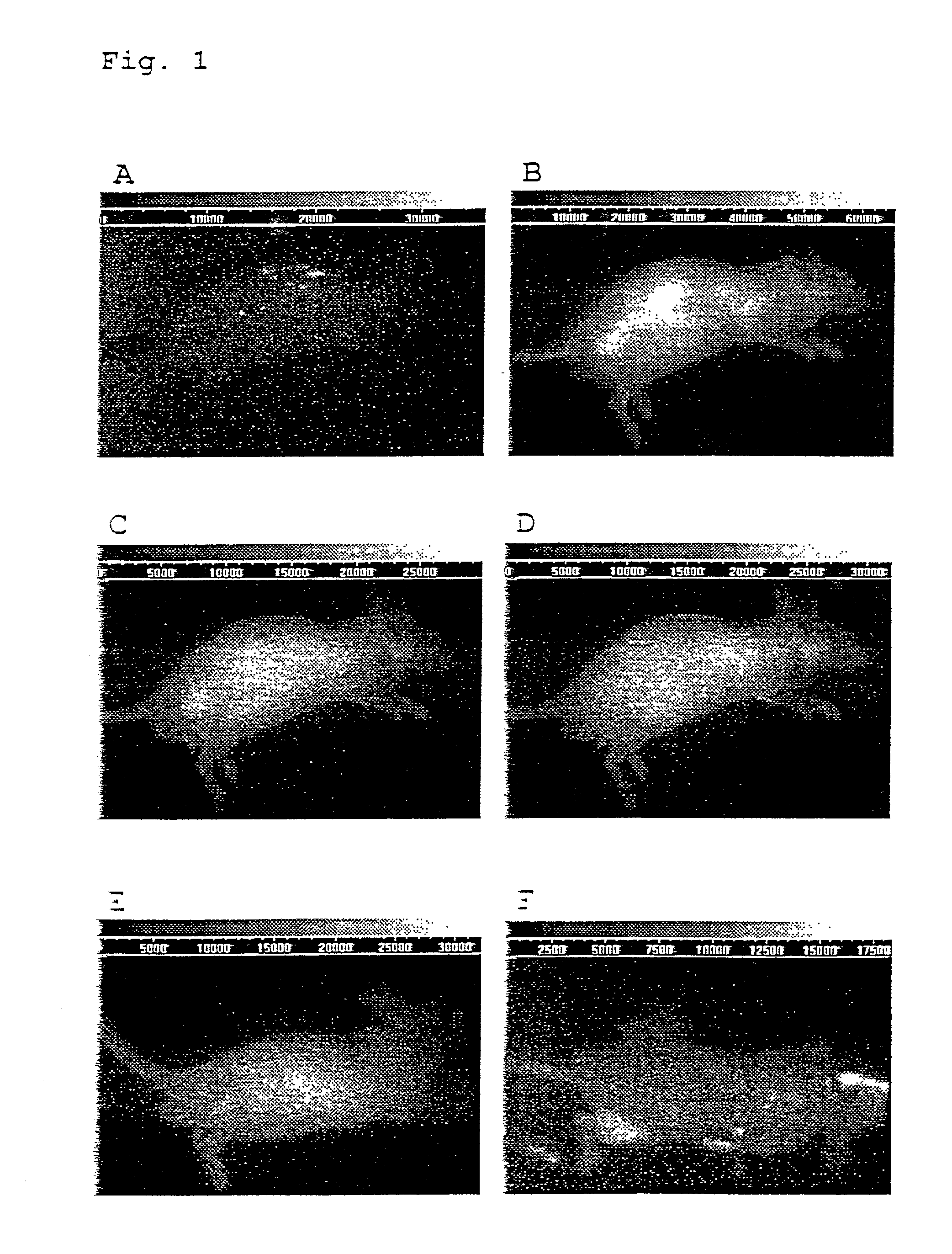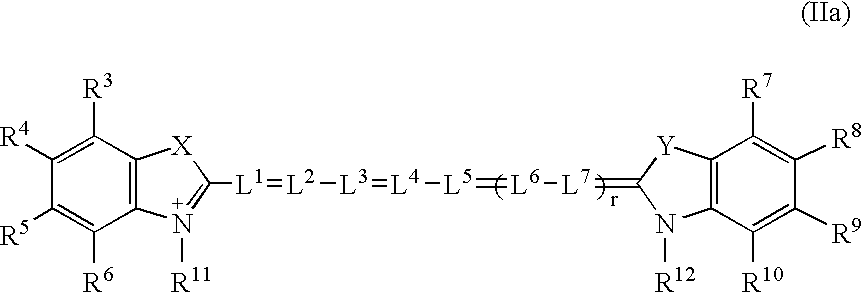In-vivo diagnostic method by means of near infrared radiation
a near infrared radiation and diagnostic method technology, applied in the field of near infrared radiation in vitro diagnostic method, can solve the problems of increasing the greater the distance from the surface, low fluorescent quantum efficiency in a hydrous environment, and extraordinarily wide scattering, so as to improve water-solubility
- Summary
- Abstract
- Description
- Claims
- Application Information
AI Technical Summary
Benefits of technology
Problems solved by technology
Method used
Image
Examples
example 1
[0153]Preparation of 5-[2-[[(1,2-dicarboxyethyl)amino]-2-oxoethyl]-2-[7-[5-[2-( 1,2-dicarboxyethyl)amino]-2oxoethyl-]-1,3-dihydro-3,3-dimethyl-1-(4-sulfobutyl)-2H-indol-2-yliden]-1,3,5-heptatrienyl]-3,3-dimethyl-1-(4-sulfobutyl)-3H-indolium, inner salt, potassium hydrogen salt.
[0154]Di-N-hydroxysuccinimide ester is prepared from 5-carboxymethyl-2-[7-[5-carboxymethyl-1,3-dihydro-3,3dimethyl-1-(4-sulfobutyl)-2H-indol-2-yliden]-1,3,5-heptatrienyl]-3,3-dimethyl-1-(4-sulfobutyl)-3H-indolium, inner salt, potassium hydrogen salt according to known methods (Cytometry 11 (1990) 418–430). 0.16 g (1.22 mmol) of aspartic acid in 1 ml of DMF are added to a solution of 0.5 g (0.51 mmol) of the disuccinimidyl ester in 5 ml DMF. The reaction mixture is stirred at room temperature for 48 h. The product is precipitated by adding ether, purified on RP-18 (LiChroprep, 15–25μ, H2O:MeOH 99:1 to 1:1) and lyophilized. 0.27 g (51%) of product are gained after drying for 24 hours at 50° C. / 0.01 mbar.
[0155]
An...
example 2
[0156]Preparation of 2-[7-[5-[2-[(11-carboxy-2-oxo-1,4,7,10-tetraaza-4,7,10-tri(carboxymethyl)-1-andecyl)amino]-2-oxoethyl]-1,3-dihydro-3,3-dimethyl-1-ethyl-2H-indol-2-yliden]-1,3,5-heptatrienyl]-3,3-dimethyl-1-(4-sulfobutyl)-3H-indolium, inner salt.
[0157]43 mg (0.65 mmol) of 85% hydrazine hydrate in 1 ml of methanol are slowly added by dropping to a solution of 0.5 g (0.73 mmol) 2-[7-[5-(carboxymethyl)-1,3-dihydro-3,3-dimethyl-1-ethyl-2H-indol-2-yliden]-1,3,5-hepta-trienyl]-3,3-dimethyl-1-(4-sulfobutyl)-3H-indolium-N-succinimidyl ester, inner salt in 5 ml of methanol (Cytometry 11 (1990) 418–430) at −10° C. and stirred for 2 hours at this temperature. The reaction mixture is evaporated under a vacuum to approx. 3 ml mixed with 1 ml of isopropanol and kept overnight at −20° C. The crystals that precipitate are sucked off and dried using the oil pump. The yield is 0.27 g (61%) of tricarbocyanine carbonic acid hydrazide.
[0158]0.27 g (0.45 mmol) of the hydrazide is added under stirring...
example 3
[0161]Preparation of 2-[7-[1,3-dihydro-3,3-dimethyl-5-[2-[(methoxypoly-oxyethylene)-amino]-2-oxoethyl]-1-(4-sulfobutyl)-2H-indol-2-yliden]-1,3,5-heptatrienyl]-3,3-dimethyl-5-[2-](methoxypolyoxyethylene) amino-2-oxoethyl]-1-(4-sulfobutyl)-3H-indolium, sodium salt.
[0162]A solution of 0.08 mmol of the N,N-disuccinimidyl ester from Example 1 in 1 ml of DMF is added to a solution of 800 mg of methoxypolyoxyethylene amine (ca. 0.16 mmol; average molar weight ca. 5000) in 10 ml of CH2Cl2 and kept agitated at room temperature for 24 hours. The solid product that precipitates after adding ether is filtered off and purified by chromatography (Sephadex G50 medium, H2O as eluent), yield approx. 58% of green-blue powder after lyophilization and drying above P2O5.
[0163]Average molar weight calc.: 10771, det.: 10820.
PUM
| Property | Measurement | Unit |
|---|---|---|
| wavelength range | aaaaa | aaaaa |
| visible wavelength | aaaaa | aaaaa |
| wavelength range | aaaaa | aaaaa |
Abstract
Description
Claims
Application Information
 Login to View More
Login to View More - R&D
- Intellectual Property
- Life Sciences
- Materials
- Tech Scout
- Unparalleled Data Quality
- Higher Quality Content
- 60% Fewer Hallucinations
Browse by: Latest US Patents, China's latest patents, Technical Efficacy Thesaurus, Application Domain, Technology Topic, Popular Technical Reports.
© 2025 PatSnap. All rights reserved.Legal|Privacy policy|Modern Slavery Act Transparency Statement|Sitemap|About US| Contact US: help@patsnap.com



